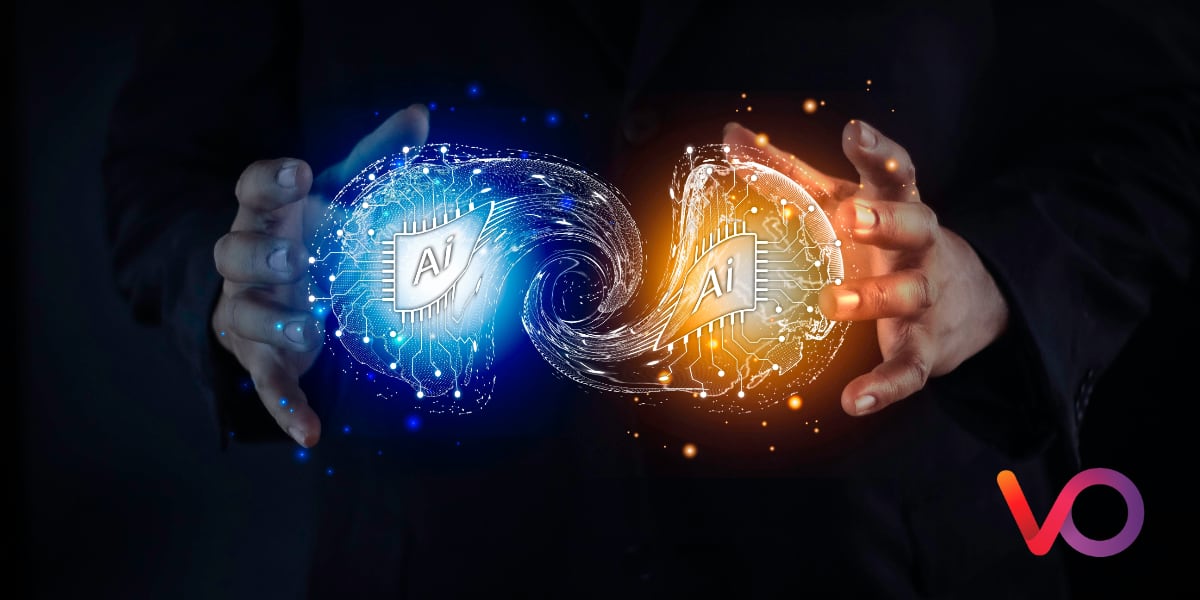If you’ve seen us on the road recently, you may have seen one of our demos about our new AI capabilities. They reveal four lessons about next year and beyond.

One of the most popular demos we have given in recent months was about AI and what effects it may have on the video industry. Certainly, at IBC2023, AI was one of our busiest demo stations, with many people — broadcasters, operators, and press — wanting to see our latest developments.
In many ways, this is unsurprising. Interest in AI is very high. It was standing room only at our Chief Data Officer, Romary Dupuis’, presentation on How Large Language Models are transforming the TV industry, and we knew it would be our focus. But, the degree of interest is still impressive as we accelerate further into deploying solutions.
We put a lot of effort into creating our demos, and these on the subject of AI were designed to showcase four main things about how its use will affect the future of the video industry.
This is what the demos showed.
1. It is becoming worryingly easy to create pirated content
We are all familiar with the sheer volume of content that Chat GPT can create to flood review listings, populate website content for SEO purposes, etc. But one of our demos took this further and showed how easy it is to create animated content.
Using a Large Language Model (LLM) based AI ‘out of the box’ with few modifications, we demonstrated how users can create their own animated series much more quickly and cheaply than even via conventional computer animation. Admittedly, there are a few complications to this in its current form.
The consistency of characters is not maintained when converting text to an image each time. Preserving character consistency in images is essential for creating movies. However, as technology continues to advance, we anticipate that this challenge will be resolved over time. Our demo has already demonstrated its potential, and with the rapid progress in AI, the likelihood of producing sophisticated animated content at scale is high in the coming year.
While animation is not VO’s niche, content security definitely is. So, our demo clearly illustrated the increasing danger posed by the emerging AI capabilities regarding content theft and rights violations.
2. Effective watermarking is a must
Protecting Intellectual Property (IP) poses a challenge for IP owners. With advancements in technology, it has become increasingly easier for others to create counterfeit content with slight modifications or even identical copies. The pirates no longer need to steal it; they can create whole series using copyrighted characters, replicating plot lines, inventing their own, or repurposing them entirely.
Extrapolate this forward to cover all video content, and you can see the potential scale of the problem.
This makes identifying content made in legitimate ways with protected IP crucial. At VO, we have already developed powerful dynamic watermarking technologies. Using these will allow content owners and others in the content value chain to identify what has been created via legitimate means and what hasn’t - and protect their IP accordingly.
3. Content recommendations are about to become even better
We have spent years using AI in its non-generative form and developing and refining our sophisticated content recommendation systems, but generative AI and LLMs offer a significant step forward in their ability.
Achieving optimal AI performance isn’t a plug-and-play process. It requires training and adaptation to optimize functionality at peak efficiency. What we have accomplished is training using our already sophisticated data sets to understand better what recommendations to surface to which consumer – and when.
Utilizing our extensive experience in recommendation systems, we can furnish precise data to empower AI in determining user preferences. Leveraging this information along with viewership history, the AI generates further recommendations. These recommendations are assessed for their effectiveness and continually refined through numerous iterations.
However, that is only the start.
Where it becomes much more sophisticated is to take all the data of the user and fine-tune it with another layer of LLM, which is only trained on data from a single household. This ensures a higher degree of accuracy and also safeguards privacy. This can be taken further, too, as this ‘localized’ AI can be tuned on the fly. Each time an individual user interacts with the recommendation carousel, these interactions can be logged and assessed, and the recommendations can be further improved.
The privacy aspect of this is critical and not only ensures the solution is compatible with privacy-era legislation such as the EU’s GDPR but also can offer transparency in why a recommendation is made (“You have been recommended Program X because you watched Movie Y,” etc) helping ease consumer acceptance of the technology.
Moreover, leveraging today's AI capabilities allows us to enhance metadata by translating it into multiple languages, incorporating semantic similarity, and more. All of these enhancements contribute to an even greater improvement in the accuracy of recommendations.
4. AI is everywhere, but how it is used varies
When it came to planning these demos, there were many more areas of our business we could have chosen from. Large Language Models are being used everywhere in the industry, and we are in the process of incorporating them throughout our product range. These were the strongest use cases for this particular trade show cycle. But by the time we reach the next one, possibly around NAB Show 2024, they will be joined by many more.
There are several things to point out here, though, regarding the usage of AI and LLMs in particular.
- Fine-tuning is the key to successful implementation. Companies like us that already have extensive datasets to train LLMs further are very much ahead of the game.
- To optimize results, we chain multiple LLMs. In content recommendations, this includes one LLM for suggestions, another for evaluation, and a third for reasoning. These specialized components work more efficiently than a single LLM, highlighting the importance of internal expertise in LLM and AI development for success.
- Privacy is vital. VO has an agreement with Microsoft Azure that enables us to develop AI effectively in a closed sandbox. Data is not exposed to the wider internet. This philosophy carries over to our consumer implementations as well.
The key takeaway is that operators looking to implement AI-powered services should therefore be careful to use trusted vendors with experience in both fields: AI and the broadcast industry.
The AI era is only just starting
Another very obvious thing at IBC2023 was genuine enthusiasm for correctly implemented AI solutions. Our customers see the benefits, and as long as the appropriate guardrails, such as protecting end-user privacy, are put in place, they are as excited as we are about how its correct implementation can enhance their services.
We've implemented an enhanced recommendation engine for IBC using LLM-based technology. In the coming months, we plan to replicate this pattern across our product line as we continuously update our technologies, spanning from TV data business analytics to anti-piracy detection. It's a bustling time for us and the industry, but with the integration of cutting-edge AI tools and techniques, it's shaping up to be an exciting journey.

